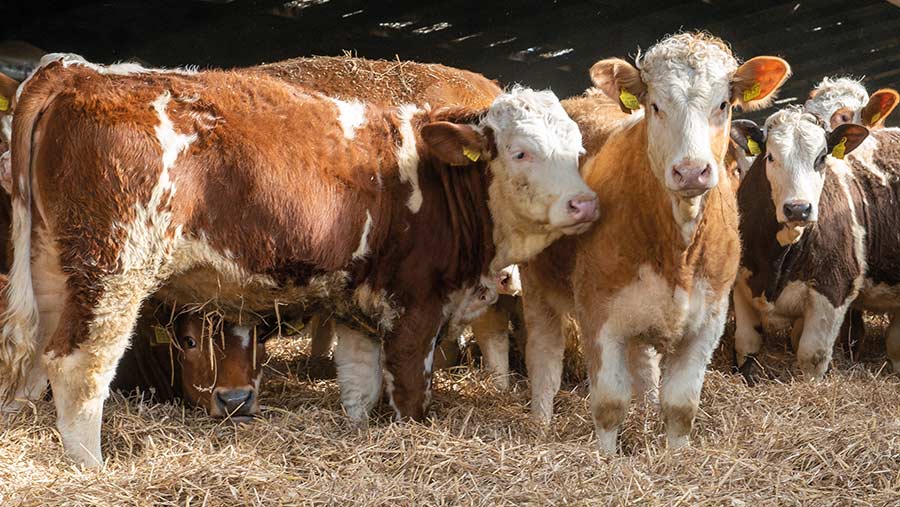Why health gains cut ruminant methane emissions by 10%
 © Angus Findlay
© Angus Findlay Three classic livestock benchmarking targets can help sheep and cattle farms raise technical performance and meet obligatory methane goals to battle climate change.
Livestock policy leaders are urging farmers to review health routines to cut methane emissions by 10% by optimising performance across three key performance indicators (KPIs):
- Daily liveweight gain
- Feed conversion rate
- Involuntary culling/abortion
Such on-farm improvements bring the added benefit of increasing production and profitability, say Nigel Miller, chairman of Ruminant Health and Welfare (RH&W) and Philip Skuce, principal scientist at the Moredun Research Institute.
See also: 21 ways beef producers can tackle net zero
They say effective farm health strategies are a “gateway” to livestock systems producing low greenhouse gas (GHG) emissions.
The advice is the nub of a joint report, Acting on methane: opportunities for the UK cattle and sheep sectors, by the two organisations, which has begun to quantify the GHG profile of key endemic diseases.
For the first time, health syndromes are ranked in order of their impact on methane emissions in dairy cattle. These are:
- Lameness
- Reproductive failure
- Bovine respiratory disease
- Diseases in neonatal calves
- Sub-clinical mastitis
- Metabolic disorders
- Involuntary culling
- Acute mastitis
Why methane matters
- Methane from agriculture accounts for almost half of global methane emissions, of which 87% is enteric (belching ruminants)
- About 45% of UK methane emissions come from ruminants
- COP26 ambitions (including US, UK and EU) are to reduce global temperature by 0.3C by 2040
- Methane has a global warming potential 80 times greater than carbon dioxide over the first 10 years in the atmosphere
- Investing in health (vaccines, vet plans, biosecurity measures) typically bring a “cost benefit”, improving margins while reducing methane emissions
- Industry measurements currently put all the “bad” practices (ploughing soil, cooling milk, using tractors, spreading fertiliser and so on) at farming’s door, but not the good, so technical performance is important to show industry progress. A farm’s carbon sequestration (for example, grassland, hedges, soil) and renewable energy output (biomass boilers, solar panels and so on) are not classed as agriculture, but “land use” and “energy” respectively, which industry leaders say is unfair.
Disease
Dr Skuce said: “The baseline work on GHG diseases, funded by both Defra and the Scottish government, found that improving livestock health and welfare could reduce methane emissions by 10%.
“This new report takes us a step further than this by mapping the GHG profile of key endemic diseases identified by RH&W with the input of farmers and veterinary health professionals.”
The report pointed to studies that showed the effect of several diseases on emissions from livestock systems, including:
- Gastrointestinal parasites: A recent study showed parasites increase GHG emissions in lamb production 10%
- Liver fluke: Infection added 19 days to slaughter in cattle, reducing growth rate by 4% and adding 2% to GHG footprint
- Johne’s: Infection has been found to lift GHG emissions by 25% a litre of milk and 40% a kilo of beef.
Referencing the Centre for Innovation Excellence in Livestock’s net-zero report, Mr Miller said farming’s response to climate change would be varied.
It would combine modern methods in slurry application technologies, precision livestock equipment and high-tech science, while also applying centuries-old methods using clovers and crop rotations.
He added GHGs remained important for the farming industry, despite fertiliser, diesel and feed price hikes along with energy security issues and the invasion of Ukraine.
“It’s a difficult world and it’s also quite hard to think that GHGs still matter, but the reality is for ruminants and climate change, the clock hasn’t stopped. We still need to make progress,” said Mr Miller.
Key livestock diseases that impact on methane production and options for control and cure |
||||
|
Disease |
Treatment available? |
Resistance complications? |
Biosecurity effect? |
Vaccine availability |
|
Bovine TB |
✅ |
|||
|
BVD |
|
✅ |
||
|
Johne’s |
✅ |
* |
||
|
BRD |
✅ |
✅ |
✅ |
|
|
IBR |
✅ |
✅ |
✅ |
|
|
Sheep scab |
✅ |
✅ |
✅ |
|
|
OPA |
✅ |
|||
|
Iceberg diseases |
✅ |
|||
|
Lameness/Codd |
✅ |
✅ |
✅ (footrot) | |
|
Gut worms |
✅ |
✅ |
✅ |
|
|
Liver fluke |
✅ |
✅ |
✅ |
|
|
Coccidia |
✅ |
✅ |
||
|
Source: Moredun Research Institute/Ruminant Health and Welfare Note: BVD = bovine viral diarrhoea; BRD = bovine respiratory disease; IBR = infectious bovine rhinotracheitis; OPA = ovine pulmonary adenocarcinoma; Codd = contagious ovine digital dermatitis *Johne’s disease vaccine reduces clinical impact in clinically affected herds but does not prevent infection spread. This is because faecal shedding is not controlled and vaccine blocks blood testing to manage the disease, so a vaccine approach is not advised. |
||||
